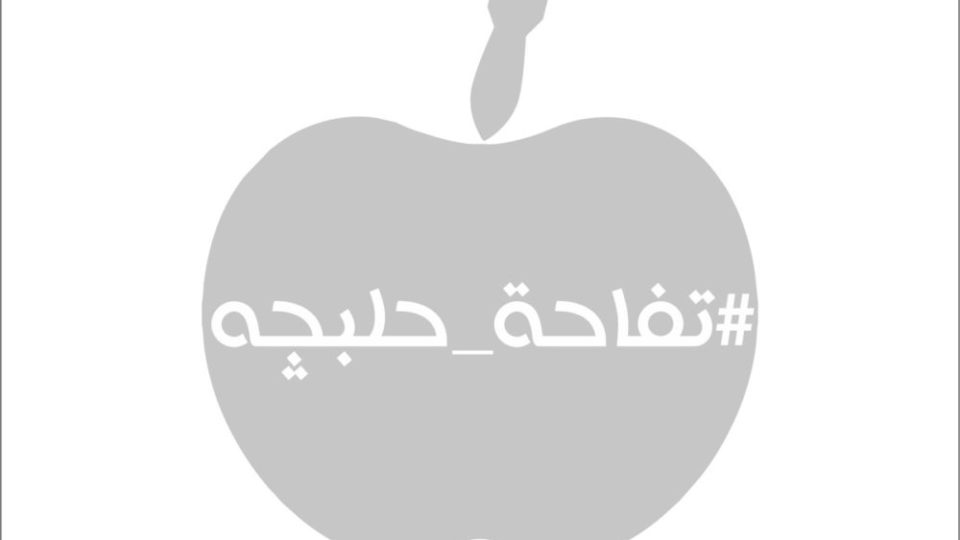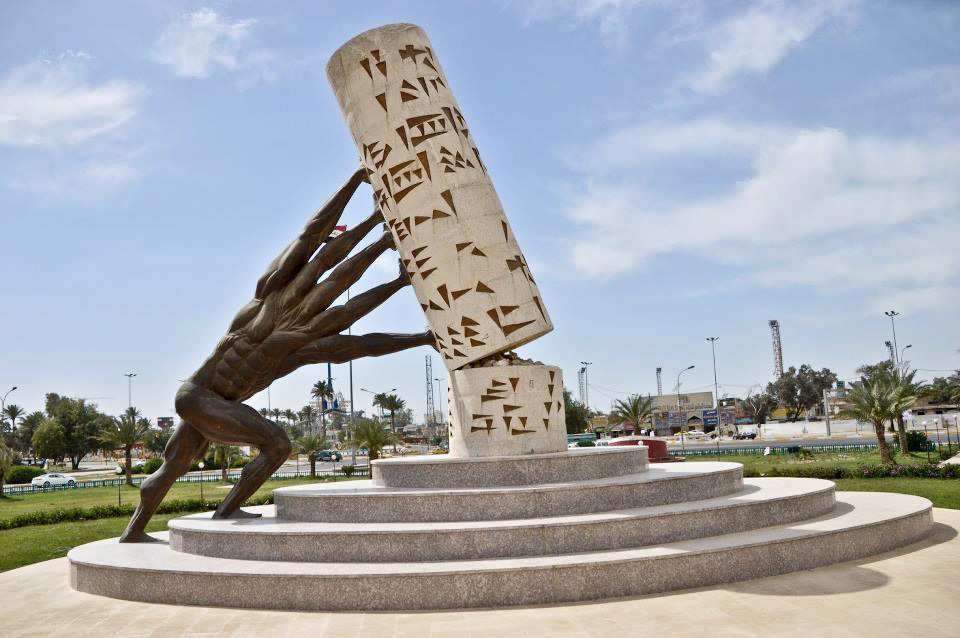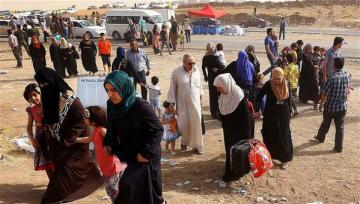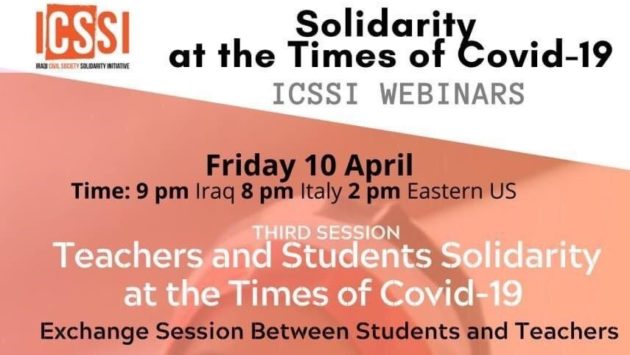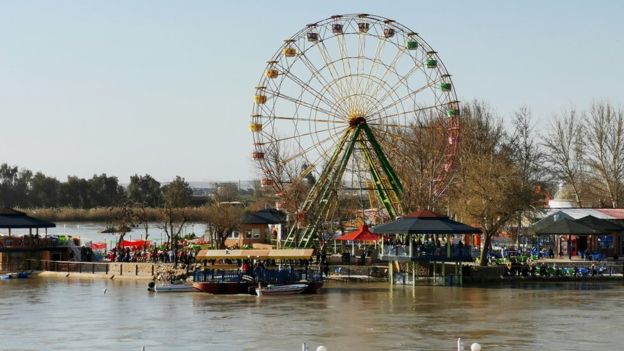The Apple of Halabja .. The Spring that did not bring Nowruz
Halabja .. An Iraqi tragedy that calls on our common humanity
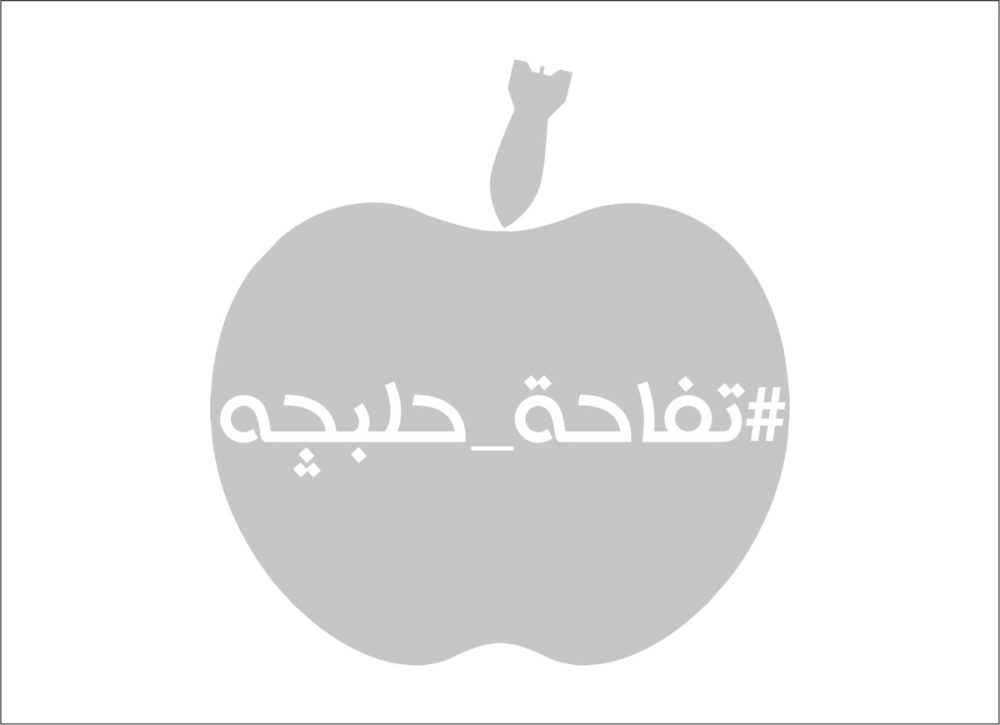
BAGHDAD, March 2017
Civil society activists from various organizations in Baghdad — Sawtona, La-Onf of Baghdad, and the Iraqi Social Forum — gathered for a moment of silent remembrance of the massacre in Halabja 29 years ago on Thursday, 16 March 2017 at the “Save Iraqi Culture” monument in Baghdad.
This initiative is particularly significant because commemorations of this tragedy are usually organized in the Kurdistan region of Iraq, often in the city that suffered directly from the attack. Choosing Baghdad this year signaled a stand, it was an explicit act of solidarity with the people of Halabja who endured this tragedy 29 years ago. The venue has some important implications.
The first is the clear sign it projects to the world of the solidarity that exists between all Iraqis, particularly the people of Baghdad with the victims of Halabja (Kurds). This solidarity cannot be diminished by the passage of time, or with the many disasters experienced by Iraqis over the years. This act of solidarity represents all Iraqis coming together over the issues and experiences that impact them, whatever their city, background, religion or ethnicity. This event lets Iraqis know that the suffering of one is felt by all. And a sense of solidarity is needed, particularly today in these difficult times.
Another significant implication of this act of commemoration in Baghdad is the message it sends out to all Iraqis of the dire need to rise up in strength and unity, despite the deep crises facing the country. It declares that Iraqi culture itself can be an effective tool to strengthen the country’s unity. We find a powerful symbol of Iraqi culture in the spot where the organizers chose to pause: in front of the monument entitled, “Save Iraqi Culture”. This monument was made by the Iraqi sculptor, Mohammed Ghani Hikmat, in 2010, and is located in the Mansour district near al-Zawraa Park in Baghdad. It consists of a broken stone column, as it teeters, off-balance and about to tumble down, but for the strength of hands and arms reaching out and stopping the column — the culture of Iraq — from falling. Written in cuneiform on the column are the words “From here writing began”.
These two aspects of the commemoration were studied well by the organizers, and are reflected in the text of their story, recounted here, as it was reported to us:
The story of the apple of Halabja, the spring that did not bring Nowruz
While Halabja was opening its hands to welcome spring, breezes blowing with the scent of apples wafted into the village. Villagers welcomed this smell, not realizing that it was in fact a chemical weapon that had silently invaded the city. Apples now are a powerful reminder to families in Halabja of those they lost that day.
Images of horror and destruction will always haunt Iraqis and the world, and the brutal ugliness of the act can not be erased: children dying in the arms of their mothers, parents closing their eyes so as not to have to see the ashes of their children, bodies on the ground bleeding from the eyes — this was a humanitarian disaster.
We have heard and seen many reports and photographs of this horrific crime, but this indirect exposure cannot replace a visit to Halabja, where one can touch the memories more closely, hear the words of its surviving inhabitants who describe the rain of deadly chemicals. One can see remnants of the toxic storm unleashed on 16 March 1988 in the remains of trees, huts, birds and animals. This was a time when Halabja traditionally prepares to receive Nowruz, in all its flourishing spring beauty. Yet 29 years ago, spring in Halabja was reduced to ashes, neither Nowruz arrived, nor did girls get to celebrate in their bright clothes to dance and welcome it.
A peninsula between water, mountains and fruit ..
A traveler must walk 80 kilometers from the city center of Sulaymaniyah to reach Halabja, passing through the mountains which overlook one of the world’s richest and the most fertile and beautiful plains, the Sharzor plain. From this point, one passes to the Sayed Sadiq district and over the Bridge of Zhalam, which crosses a fast running river, flowing from the mountaintops bordering Iraq and Iran — a place of such a great height that snow remains on the peaks for most of the year.
No one can imagine the horror and destruction wrought that spring of 1988: the Iranian forces had swept through the city and crossed the bridge of Zhalam. For a few days, the population was bombarded with gunfire and shelling from both sides. At 11:30am on 16 March, the sky over the city was suddenly filled with swarms of bombing aircraft, some carrying balloons to determine the direction of the wind. 6 to 12 planes attacked with massive bombardments on homes, farms, streets and people who tried desperately to flee into the mountains.
Mustard and nerve gases showered down on Halabja that day. Survivors say that the sky over the city filled with brightly colored smoke clouds, a stark and eerie contrast to the death they brought. Some civilians burned to death, others died from suffocation or swelling, and some suffered from ‘blue body’, resulting in eyes which literally popped out of their sockets. Others died from laughing, an ominous effect of the deadly gas.
Tales from the lips of survivors of hell..
Next to the old cemetery in Halabja, nearly 1500 bodies were buried, and a symbolic cemetery was erected as evidence of the massacre that killed so many. On each stone, names of the dead were written — a number reaching 5000, according to the most trustworthy statistics. And this number excludes those who died in the camps and hospitals in Iran, those who had to be buried outside their homeland. A marble statue marks the cemetery — a girl raising her hands to the sky, screaming, and cutting the chains of slavery and death which bind her. It is as if she were reproaching the whole of humanity, calling the world to remember, to sit with its guilt, so that there will never be another Halabja. The survivors of 16 March 1988 will never be liberated from their memories of that black spring.
Habib Hassan Ali, one of the survivors, now aged 70, works in the cemetery which holds so many of those who died that day. He lost many family members to the massacre, and recalls: ‘We fled to the Ababili village, but the smell of smoke haunted us. Others fled toward the mountains, but no one knew where he was going, no one knew what happened to his son or his brother or his wife or his father or his mother. And no one remembered to ask about his neighbors or relatives — the important thing was to escapes and survive’
Another survivor, Abdulrahman Aziz Amin, 44 years old, said that he could not find his family until a month after the disaster in one of the camps. His brother passed away in an Iranian hospital far from his home and family.
The visitor to the city of Halabja today does not need to search far to find dozens of survivors, and will inevitably come across those willing to tell their harrowing stories. The village itself speaks through silent images of its graves, of houses one passes, once homes to those who were killed. There are still many inhabitants of Halabja who are wounded and disabled, disfigured by the gas, suffering from infertility and immune disorders. The psychological impact also lives on, as one sees in the faces of those who were spared.
Today, 29 years after this tragedy, we stand in solidarity with the victims. We stand in solidarity to ensure that the horror of 16 March 1988 will never be repeated, that the wounds it inflicted will be healed, and to proclaim that together we can build a new life for our future generations, a life filled with peace, coexistence and tolerance.
Halabja is in our hearts and the hearts of all Iraqis, and we offer our condolences and support to the families of the victims.
Halabja .. An Iraqi tragedy that calls on our common humanity

